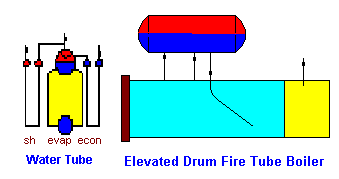FOULING
IN WASTE HEAT BOILERS by V.Ganapathy
This
article describes how one may evaluate fire tube and water tube boilers
for fouling.Fouling on water,steam side can affect the boiler in several
ways.The exit gas temperature will increase,thus resulting in loss of energy
recovery and reduced steam production. Tube wall temperature can increase
signifcantly leading to tube failures due to scale formation. Fouling on
gas side leads to loss of steam output and can increase the gas side pressure
drop.However it does not increase the tube wall temperatures. The simple
procedure developed here explains how the evaporator performance may be
evaluated for possible fouling.One may also compute the exit gas temperature
and compare it against operating data to see if fouling has occurred.
Performance
of Evaporators
The
performance of an evaporator(fire tube or water tube,bare or finned) may
be obtained by solving the following equations:(The performance evaluation
of superheater,economizers
are more involved and readers may see my books,"Waste Heat Boiler Deskbook"
or "Steam Plant Calculations Manual").
Q=WgCpg(tg1-tg2)hl
=USDT=US[(tg1-ts)-(tg2-ts)]/ln[(tg1-ts)/(tg2-ts)]
Wg=gas
flow,lb/h
tg1,tg2,ts=gas
inlet and exit temperatures and saturation steam temperature,F
Cpg=gas
specific heat,btu/lbF
hl=heat
loss,factor.1 % heat loss means hl=0.99
U=overall
heat transfer coefficient,Btu/ft2hF
S=surface
area,ft2
DT=log-mean-temperature
difference,F
Simplifying
the above,we have:
ln[(tg1-ts)/(tg2-ts)]=US/(WgCpgxhl) |

|
Example
of a Fire Tube Boiler
Let
us assume that a fire tube boiler is operating as shown below in clean
conditions:
gas
inlet temperature=1500 F
gas
flow=100,000 lb/h
gas
exit temperature in clean conditions=500 F
steam
pressure=150 psig (ts=366 F)
feed
water temperature=230 F
blow
down=5 %
tubes:
2x1.77in,600 tubes,20 ft long,surface area=6280 ft2(OD basis)
Duty=100,000x.98x.287x1000=28.1
Mm Btu/h and steam=27,710 lb/h
Let
us compute U.
ln[(1500-366)/(500-366)]=Ux6280/(100,000x0.287x0.98)
or U=9.56 Btu/ft2hF
Let
us assume that a scale has formed and the equivalent additional fouling=0.05
ft2hF/Btu. What happens to the performance?
This
will decrease U to: 1/(1/9.56)+.05)=6.5 Btu/ft2hF
This
in turn will affect the exit gas temperature as follows:
ln[(1500-366)/(tg2-366)]=6.5x6280/(100,000x.98x0.287)
or tg2=630 F
The
duty=100,000x0.98x0.287x(1500-630)=24.4 Mm Btu/h and steam generation=24,100
lb/h
Table
below summarises the results.(For more detailed calculations of tube wall
temperatures,heat flux,see my books) Note
that even though the heat flux has reduced due to lower U in fouled condition,the
tube wall temperature is significantly higher!
| item |
clean |
fouled |
| fouling factor,ft2hF/Btu |
.001 |
.05 |
| U,Btu/ft2hF |
9.6 |
6.5 |
| heat flux,Btu/ft2h |
6086 |
4133 |
| drop across scale,F |
6 |
207 |
| tube wall temp,F |
377 |
577 |
| duty,MM Btu/h |
28.13 |
24.47 |
| exit gas temperature,F |
500 |
630 |
| steam flow,lb/h |
27,710 |
24,100 |
The difference
in energy loss at 3$/MM Btu=3.66x8000x3=$ 87,800 per year
Calculations
for a water tube boiler are similar.One can also use the above equation
to adjust for variations in gas flow by correcting U by (gas flow)0.6
for water tube boilers and (gas flow)0.8 for fire tube boilers
inorder to check if surfaces have fouled. See my books for more examples.
The
type of scale formed also affects the fouling resistance and the increase
in tube wall temperatures as shown below.
Effect of scale
conductivity on tube wall temperatures
| scale |
ther
cond,Btu in/ft2h |
fouling
resistance |
temperature
rise,F |
| calcium phospate |
25 |
0.0008 |
8 |
| calcium sulfate |
16 |
0.00125 |
13 |
| magnesium phospate |
15 |
0.00133 |
14 |
| silicate |
0.6 |
0.0333 |
333 |
| boiler steel |
310 |
0.00006 |
0.6 |
| magnetic iron oxide |
20 |
0.001 |
10 |
[ for
a scale thickness=0.02 in,heat flux=10,000 Btu/ft2h; fouling
resistance=thickness/th cond]
It
is seen that even a small layer of silicate can increase the tube wall
temperatures significantly.So one has to monitor the boiler performance,watch
for increases in exit gas temperatures,tube wall temperatures or loss of
steam production for the same gas inlet conditions.In
the case of finned tube evaporators,the heat flux inside tubes will be
very high compared to a bare tube boiler and hence even a small fouling
layer can increase the tube wall temperature significantly.

Books,Software
on Boilers,HRSGS,Steam Plant Calculations
email Ganapathy
